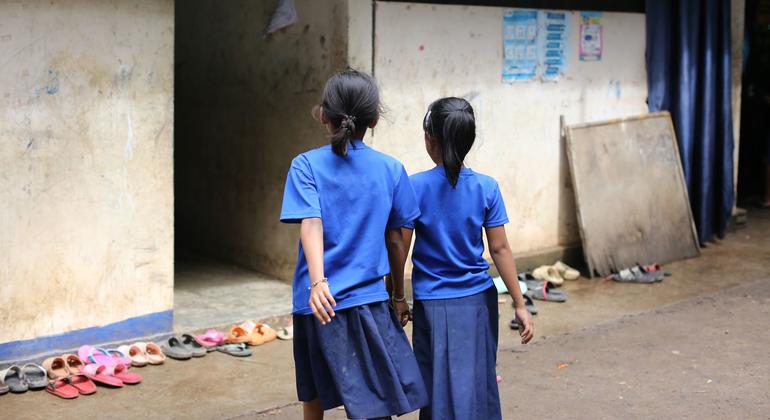Overcoming challenges beyond the classroom is a daily reality for educators at 63 learning centers in Thailand’s Tak province. Some of the teachers and directors at Thailand’s migrant learning centers along the border with Myanmar are doing their best to keep up, with the support of the United Nations, with the children arriving in the country. seeking refuge.
Currently, educators in this province serve about 14,400 students, up from 11,450 in 2020, according to the Thai education ministry office that supports basic education in five border districts: Mae Sot, Phop Phra, Mae Ramat, Tha Song Yang and Umphang.
However, teachers and principals find solutions by assuming the role of parents, farmers, traders and sometimes as one-man non-governmental organizations (NGOs), with limited resources.
The day begins at dawn
The director of a learning center for migrants in the Phop Phra district, about 450 km northwest of Bangkok, cares for about 110 children from preschool to sixth grade, including 20 students who live in her dormitories.
Their day begins at dawn and ends well into the night. He teaches, manages the center’s finances, collects firewood, prepares food and cooks.. She also cares for and comforts dozens of children in place of their parents, who work elsewhere in Thailand or in their home country.
Their hard work is unpaid. Of the six teachers at the center, all of them in their 30s, only three receive a small monthly stipend of 3,000 Thai baht ($80), an amount less than half the average worker’s salary, which is around $200.
Additional works
The situation is the same throughout Tak province. Like many other teachers at learning centers in the area, the 48-year-old director in Phop Phra district has been earning extra income for her center.
She cooks mote si kyaw, a popular Myanmar fried pastry made with rice flour, to sell at a modest profit, and also keeps a few goats to sell when the center is in special need of extra money.
“I do everything I can,” he says. “This center is my life.”

Ensure food safety and more
In Mae Ramat district, located less than a kilometer from the border with Myanmar, there is a learning center for migrants that can only be accessed by a bumpy road eight kilometers from the main highway. It relies on five limited-use solar panel units for dormitory lighting and groundwater pumping, according to its 29-year-old director.
He says his staff, made up of five other teachers, works hard to care for the needs of his 50 residents, growing their own rice and maintaining plumbing and filtration systems for a clean water supply.
“Although the children are safe here, they are worried about their parents in Myanmar,” he says.

Shots are still heard
Before the conflicts in Myanmar, many children followed their parents, who sought work in Thailand. However, With ongoing conflicts on the immediate horizon, returning “home” is not an option.
For them, staying in school means being protected, says the 38-year-old deputy director of a center for about 200 children in Mae Sot district, about 10 km from the border with Myanmar.
“We can still hear gunshots when there is fighting, but the children feel safe here,” he said, adding: “We do everything we can to keep the center open for the children.”

Support for education and more
However, many educators expressed concern about the operating costs of their centers and whether they will be able to accommodate the expected influx of more students and guarantee the well-deserved safety of children.
To support ongoing efforts, Pilat Udomwong, director of the Thai Ministry of Education’s Tak province office, said his mission is to monitor operating conditions, register migrant teachers and students, and support the centers through associations.
Some projects have already produced results, such as one supported by the Japanese government and the regional office of the United Nations Organization for Education, Science and Culture (UNESCO) in Bangkok which, since last August, includes upgrading facilities, installing IT equipment for flexible learning programs and delivering food to support the 20 centers with basic accommodation.
Thanks to that, More than 7,000 immigrant students now have three nutritious meals a day.

Grow to have a better life
During a recent field visit, education program specialist at UNESCO Bangkok Office, Rika Yorozu, stressed that the right to education is part of the agency’s mandate.
“We want to ensure that children receive continued support to continue learning, regardless of their nationality,” he said. “The teachers [de los centros de aprendizaje para inmigrantes] They are doing a tremendous job. “They are very dedicated and need this support.”
While assistance is implemented, teaching workers continue to take on multiple roles to keep their centers running. The director of a center in Phop Phra summed up a common sentiment that resonates in many districts.
“I will continue to do these things for children,” he said. “My happiness is seeing children smile, be safe, well fed and grow up to have a better life.”








![[Img #74678]](https://thelatestnews.world/wp-content/uploads/2024/12/See-schizophrenia-and-bipolar-disorder-in-face-shape-150x150.jpg)


Add Comment